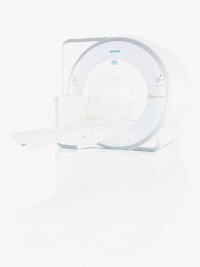by
Sean Ruck, Contributing Editor | June 14, 2011

Image courtesy of Siemens
From the June 2011 issue of HealthCare Business News magazine
Welcome to the yearly round-up of the top topics in nuclear medicine imaging. The last 12 months have provided a lot to talk about, from the first glimpse of new modalities, to the end of an isotope shortage, to market shifts and
developments in radiopharmaceuticals.
Hybrids are a hit
The high desirability of PET has led to a number of hybrid offshoots. PET/CT has been around for a decade but some new combinations may not be far off. For example, at RSNA 2010, Siemens Medical Solutions introduced the world’s first PET-MR, the Biograph mMR. The system still requires 510(k) review by the Food and Drug Administration.
While Siemens had the big reveal, Philips Healthcare was the first to make it to market with its own PET-MRI system, which has receive CE marking for sale in Europe. The Ingenuity TF PET/MR is the first new imaging modality introduced by the company in a decade.



Ad Statistics
Times Displayed: 175234
Times Visited: 3189 For those who need to move fast and expand clinical capabilities -- and would love new equipment -- the uCT 550 Advance offers a new fully configured 80-slice CT in up to 2 weeks with routine maintenance and parts and Software Upgrades for Life™ included.
The case for SPECT
PET hybrids may be cutting into the SPECT pie, but the SPECT is still a workhorse used in about 7 million procedures each year and will likely hold that position for some time. In part, the large install base in the United States provides security as the devices work off their debt to the facilities utilizing them. Few facilities will readily discard a machine performing the required imaging, to pay a significantly higher price for PET especially with the fast and furious rate new hybrids and radiopharmaceuticals are being developed.
A second point in SPECT’s favor is what may be antiquated insurance regulations. “If you have a patient with a high BMI and they’re going to need a PET scan, why not go straight to it?” says Joe Mathews, director of sales and operations for Nuclear Medicine Professionals Inc. “The only reason preventing that direct move to PET is that an insurance company is mandating a certain sequence of testing.”
However, the SPECT story isn’t all good news.
Shortages of certain radioisotopes may darken its future.
The give and take of Medicare
According to Mathews, certain steps must be taken to meet mandated insurance requirements, like a non-nuclear stress test, followed by a nuclear stress test, and then a PET exam. That means a lot of hoops to jump through and health care insurance providers may add or subtract from the number of hoops at any time. Of course, Medicare, the largest health care insurer in the country has had the most impact being directly tied to rules and regulations passed down from the federal level.

